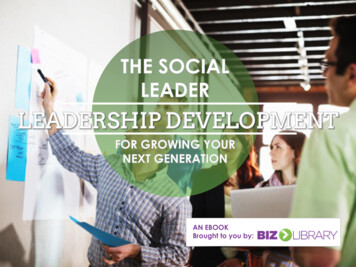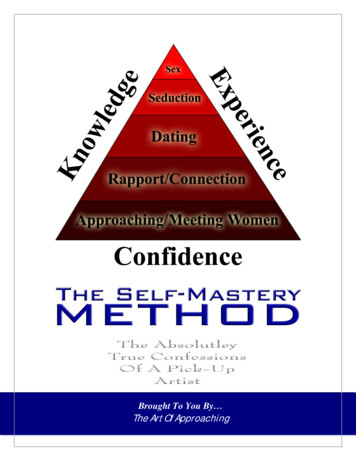
Transcription
AN EBOOKBrought to you by:
LEADERSHIP MODELS AND TODAY’S WORKPLACEThe history of leadership models for development purposes isfascinating. When we look carefully at the broad timeline of thevarious leadership models and theories that the business andGreat Man Theories: leaders are born, notmade.academic communities have promoted, we’ll find a relativelyGroup Theories: leadership emerges inaccurate reflection of the core business models at work in corporatesmall group settings.America. Leadership theories and models are developed in a definitesocial and economic context. So the models reflect the attitudes andTrait Theories : there are universalapproaches to business management and leadership of the times inleadership traits that can be taught andwhich the various theories and models emerged.learned.The dramatic changes we are witnessing today in our economybrought about by innovative technology, demographics, shiftingeconomic realities and a myriad of other factors are forcing thebusiness and academic communities to look at wide range ofBehavior Theories: behavior patterns thatresult in leadership success.Contingency/Situational Theories:leadership behaviors in specific situations.business issues, including leadership. We are seeing a new leadershipmodel emerge. Social leadership is taking root in successfulExcellence Theories: the interactionsorganizations across every industry and in organizations of every size.between traits, behaviors, key situationsWill the social leadership model replace current models? Probablyand group facilitation that allow people tonot. But we can be fairly certain traditional business models,lead organizations.methodologies and leadership models will need to evolve to meetthe challenges of this marketplace.BIZLIBRARY.COMTransformational Theories: motivation,alignment and sometimes values.
LEADERSHIP MODELS AND TODAY’S WORKPLACEWe’ve learned that organizations thrive when they adopt leadershipmodels that work best for themselves. Each organization has its ownculture and needs, so while leadership models help provide a greatframework for development, the models themselves are no substitutefor the development of a leadership strategy that fits the needs,culture, and goals of each organization. Successful organizationsadopt leadership models that meet two critical types of leadershipchallenges: current and future. The social leadership model. 1,195 Influential factors that maymitigate in favor of adopting thismodel or even parts of thisGreat leadership development programs are rooted in the realities ofleadership model for yourthe marketplace and the anticipated future needs of theorganization.organization. The characteristics and traitsIn this marketplace and the changing demographics of theworkforce, we believe a leadership approach based upon a fixedpoint world view, unchanged and inflexible will not be effective.Whether social leadership is right for your organization or not, acareful and deliberate re-examination of your leadership needs willcommon in effective socialleaders. Emerging competencies thatmight be important to developprove beneficial no matter what strategic leadership approach isin social leaders in yourbest for your organization.organization.BIZLIBRARY.COM
Management isdoing things right.Leadership is doingthe right things.Peter Drucker
WHAT ARE THE RIGHT THINGS?Exactly what are the “right things” our leaders need to do? For most organizationsthe most basic answer is promote organizational goals and objectives. As we statedin the introduction, great leadership development programs focus on multiplefactors to answer this foundational question. It’s nearly impossible to effectively setgoals for our organization if we do not account for the various factors impacting ourorganization from the outside.So – what are the “right things”? How do you make this decision for yourorganization?“The leaders who work mosteffectively, it seems to me, neversay ‘I’. And that’s not because1. What do you need your leaders to do today?2. What will you need your leaders to do tomorrow?they have trained themselves notto say ‘I’ . They don’t think ‘I’. TheyYou cannot develop effective leaders if you are looking only at short-term orimmediate success. You have to ALSO look at the future!think ‘we’; they think ‘team’. TheyA great method to answer these vitally important questions is to conduct a SWOTanalysis. This analysis is a great way to start to figure out EXACTLY what your leadersneed to do!make the team function. TheyStrengths: what do we do well today, and can we take these strengths forward? Willour current strengths prepare us for future success?credit This is what creates trusts,Weaknesses: what do we do poorly and why? Can we do LESS of this? If not, whyand what steps must we take to either improve or minimize the risks?done.”Opportunities: what are our greatest opportunities for growth? Are our strengthsaligned to take advantage of them? Or, do our weaknesses stand in the way?Threats: where are we vulnerable? Are our biggest threats external or internal?Market driven or competition? Lack of talent or not the right talent?BIZLIBRARY.COMunderstand their job to be toaccept responsibility and don’tsidestep it, but ‘we’ gets thewhat enables you to get the taskPeter Drucker
SWOT ANALYSISIn an effective SWOT analysis, what will you find when you look at the currentmarketplace and economy? Stability? Simplicity? Predictability? Clarity? Or, will youfind something else entirely?BIGDEMOGRAPHIC TSUNAMIDATAEvery day, we create 2.5 quintillionbytes of data so much that 90%of the data in the world today hasbeen created in the last two yearsalone.IBM’s Understanding Big Data:Analytics for Enterprise ClassHadoop and Streaming DataIn the four generation workplace,Millennials will make up almost 36%of the 2014 U.S. workforce andbecome almost half by 2020.Boomers are retiring at recordnumbers.U.S. Bureau of Labor StatisticsSWOT analysis is a simple tool thatcan function in two ways: as anice breaker to get conversationsstarted or in a more sophisticatedway for strategy development.S – strengths: internal strengths of anorganization based upon things theTECHNOLOGY ADVANCESTechnologies can change the gamefor businesses, creating entirely newproducts and services, as well asshifting pools of value betweenproducers and consumers.McKinsey Global InstituteEMPLOYEE ENGAGEMENT10% of US workers are disengagedand 60% are actively disengaged.Gallup State of the AmericanWorkforce 2013organization does very well.W – weaknesses: internalimprovements needed to besuccessful or things to avoid.O – opportunities: improve results byleveraging strengths or eliminatingEMPLOYEE TURNOVER AND RETENTIONNearly 26% of the US workforce is going to change jobs this year, and theseare typically the most highly skilled and motivated people.Why Companies Fail to Engage Today’s Workforce: TheOverwhelmed Employee, Forbes, by Josh BersinBIZLIBRARY.COMweaknesses.T – threats: obstacles to success,external factors such as competitors orbroad market changes.
A FRAMEWORK FOR SUCCESSThe acronym VUCA describes this market. It stands for volatility, uncertainty,complexity and ambiguity.How do we prepare our organizations for success in such a world, and what do weneed our leaders to do?Traditional leadership models will not work. In this world, we can find a whole newset of strengths in our changing demographics with young professionals ready toadapt to and utilize technology differently. We will need a different leadershipmodel to help bring a sense of order to the chaos “big data” can create. As newmarkets emerge, we’ll need a more agile and rapidly moving innovative culture tobe more opportunistic. And we’ll need a leadership model that can provide aframework for effective action and decision-making in the face of complexity andambiguity.What skills, knowledge and competencies are needed to:The VUCA world requires a new setof skills and competencies fromboth organizations and leaders toeffectively respond.Success in a VUCA world willrequire successful organizationsand leaders to be highly engaged Leverage strengthswith change, complexity and Overcome weaknessesambiguity. Take advantage of opportunities Address/meet threatsThen – WHERE is the CURRENT level of leadership capability? Or, at what level do ourleaders currently perform? What level of capacity do we need in the future andwhere are our gaps?Is there a leadership model that can provide a framework for success? We believethe answer is, “Yes.”BIZLIBRARY.COMWe are going to shift from problemsolving to working our way throughdilemmas.
SOCIAL LEADERSHIP COMPARED TO OTHER MODELSTraditional leadership models provide a framework for behaviors and development that focuses on the individualleader. Even the most advanced models such as the Transformational Leadership model define leadership success interms of what the leader does for, and sometimes to, the people he or she leads. According to Bernard Bass,Leadership and Development, NY Free Press, 1985, one of the foremost early researchers on the concept oftransformational leaders, transformational leadership can be defined based on the impact that it has on followers. Sothese leaders garner trust, respect, and admiration from their followers.Social leadership shifts focus awayfrom the impact on immediatefollowers to a broader context. Socialleaders influence entire organizationsand exert influence beyond theorganization itself.WHAT IS SOCIAL LEADERSHIP?An emerging model of leadershipbuilt around three central principles: Leadership is collaborative Leadership is a process Leadership should be value basedWhen we think of social leadership inthis broader context, the model startsto look a lot more like a behavior andcompetency model that might bemore effective in this VUCA world,and it revolves around learning.BIZLIBRARY.COMNEXT GENERATION LEARNING STRATEGIES:Alignment with organizational goals.A sharp focus and clarity of thinking on the specific way our employeelearning efforts align with and support organizational goals.Awareness of organization’s current learning culture.Understanding your culture will help to achieve the desired behavior andperformance changes sought through the learning program.Performance analysis.The performance analysis helps you focus on the business challengesthat can be met through a learning program.Content strategy.Make sure you have a content strategy that meets the needs, behaviors,expectations and technology availability of your entire workforce .Evaluation and success criteria.What will success look like? How will we know?Marketing and communication.Inform your employees about the program, motivate them toparticipate, explain how the program will help them.
RETURN ON INVESTMENT – SOCIAL LEADERSHIP IN ACTIONSo, what does a social leader look like and how do they function? At the core of social leadership lies an outwardlooking individual far more interested in others than his or her own success. These are people either “hard-wired” tocollaborate or people who have learned to collaborate effectively. But collaboration for this leader isn’t just a workmode. It’s a fully integrated part of who they are. They share information, learn all of the time, connect in meaningfulways with those around them. These are people who really understand that “crowd wisdom” is real. These are peoplewho know the most valuable member of a team is the person other team members can count on to shareinformation and connect other team members to other people who can help them. These are people who network –all of the time, both internally and externally.In business, there used to be an axiom that “knowledge is power.” Social leaders do not believe that knowledge,standing alone is power. Social leaders believe that “shared knowledge” is power,” and that in today’s collaborative,innovation driven marketplace it’s the ability to influence outcomes that is the source of true business success.COMMON TRAITS OF SOCIAL LEADERSPragmatic optimistDefaults to “yes”InspirationalCo-create value and develop excellenceForward lookingEmbrace change by asking “what if ?”Open mindedSolicit views from othersProactiveThe first to follow, the first to leadTrustingThe only path to scale is empowermentAccountableI’ve got itGenerousWhen celebrating, lead from the backAuthenticOpen and honest communicationCollaborativeNo one of us is as smart as all of usBIZLIBRARY.COMThe Pursuit ofSocial BusinessExcellenceby Vala Ajsharand Brad W.MartinHow to compete, win andgrow market share - anddelight employees andcustomers - though socialcollaboration.
ELEMENTS OF A SOCIAL LEADERSHIP MODELThis model is much closer to something businessorganizations can apply and modify to meet their ownunique needs. The elements of this model that work welland should prompt good thinking are:Outward focus : the leader is a hub for connecting otherpeople to information and each other.ENGAGESFACILITATOROF LEARNINGTechnology literate: with rapid changes and innovationsin technology in general, and social technology inparticular, social leaders will need to be early adaptorsto truly lead and stay with or a bit ahead of employees.STRONGNETWORKSLearning is important: we see the employee learningfunction becoming less and less centralized and lessformal. Employees and front-line managers will be muchmore involved in education and learning, and morelearning will be informal and technology-based thanever before.Engagement focuses: we already know engagedemployees drive a number of important businessbenefits, and social leadership will help drive higherlevels of engagement. In other words, social leadershipwill be good for the bottom-line.LEADERSHIP and LEARNING areindispensable to each other.John F. RNINGSHARINGANDINFLUENCE
LEADERSHIP COMPETENCIESTraditionally, here are a few of the core competenciesidentified as important for leaders:VisionAnticipate TheFutureInterpersonal SkillsAbility To Develop e traits or competencies are still important, but amodern view of leadership is emerging that adds ormodifies some of these concepts in important ways.In the book, The 20/20 Workplace by Jeanne Meisterand Karie Willyerd, a set of emerging competencies foremployees and leaders are identified.These competencies will be essential for our leaders asour organizations continue to adapt and evolve.BIZLIBRARY.COMPeopleDevelopmentDigital LiteracyGlobal Citizenship
EMERGING COMPETENCIESThe leadership competencies needed to effectively function in a social leadershipmodel will evolve over time, but we are already seeing some critical competenciesrise in importance.Collaboration.Collaboration will be a foundational skill for nearly every knowledge employee inthe most successful organizations in this marketplace. Big data isn’t just a trend thatleads to e-mail overload, nor is it a trend that refers to the volume of funny catvideos loaded to YouTube each week. Big data is an overwhelming reality thatmeans more information and knowledge is being generated and at a faster ratethan ever before. It’s nearly impossible for a single organization to keep up, muchless an individual. The only way people can stay informed about trends, marketconditions, and industry developments is through collaboration, information sharingand cooperation. Collaboration will be critical to gather input from as manyperspectives as possible and just about any sort of project, and this will be one ofthose foundational skills just about every employee and certainly every leader willneed to master at some level.LEARN WHILE YOU WORK, WORKWHILE YOU LEARNJob Rotation:Move employees around andchallenge them to get out of theircomfort zones. A deliberatedisruption of routine puts new setsof eyes on familiar task andproblems, and can lead to newRECOMMENDED RESOURCES FROM THE BIZLIBRARY COLLECTION:Course Title: Ban the Hierarchy: Moving From‘I’ to ‘We’Banning the hierarchy means there are nocharts with up and down arrows.Course Title: Collaboration CreatesValueSwitch from consensus-basedcollaboration to ideation. Do it early,when the ideas are needed most.BIZLIBRARY.COMand better solutions.Individuals acquire a betterunderstanding of how the entireorganization operates and howdifferent departments or unitsCLICK HERE TOTRY THESERESOURCESAND MORE!other than their own operate andinteract.
EMERGING COMPETENCIESLearning Agility.The complex business world we live in requires a new set of skills and competenciesfor both organizations and leaders. The business world with a “fixed point” frame ofreference simply does not exist. If we develop leaders using a leadership model thatdoes not fully and completely embrace ambiguity and complexity, we are settingour leaders up to fail. This marketplace requires a new approach to leadership."All of those attributes that describe the business world of today are tailor-made forsomeone with learning agility," says Victoria Swisher, who's authored a new book,Becoming an Agile Leader. "The hallmark of someone with learning agility is thatthey learn lessons from diverse experiences and are able to distill those down torules of thumb so that, when they're put in an unfamiliar situation, they aren'tstumped by it. It's almost becomes a price of entry for success now, especially inleadership and executive roles.“We need leaders who learn from experience, because those leaders can beproven to be more successful than leaders who do not learn from experience andapply what they have learned. This research was summarized in a Korn/FerryInstitute white paper titled, “Using Learning Agility to Identify High Potentials Aroundthe World”. So, generally speaking, learning agility is used to describe people whoare open to new things, willing to learn, curious, possessing good people skills andhave a high tolerance for ambiguity. These are behaviors which can be learned.We are moving from a world ofproblems, which demand speed,analysis and elimination ofuncertainty to solve – to a world ofdilemmas, which demandpatience, sense-making and anengagement with uncertainty.Denise Caron, It’s a VUCA WorldAs the need for agility moves down the managerial chain and into the functional units, it can manifest itself in differentways. At the level of an individual contributor, agility is demonstrated by the ability to quickly solve day-to-day businessproblems, to identify new processes and frameworks for speed of delivery, to cross global and functional lines withoutfaltering, and to accept, respond, and initiate change. Employees who can identify opportunities, adapt, and thrive in thereality of change have a propensity to be high performers. Given the right resources and investment in learning, these traitsare achievable across the entire organization.The Impact of Work Force Agility on Business PerformanceBy John AmbroseBIZLIBRARY.COM
EMERGING COMPETENCIESPeople Development.Organizations have always needed leaders who could build the skills andcompetencies of the people around them, and this continues to be a criticalcompetency for leaders. As we see members of the Millennial Generation join theworkforce in greater numbers, the need for professional development will be moreimportant than ever. Millennials value collaboration, meaningful work andopportunities for development, among other things, in their jobs. So we are going toneed managers and leaders with the ability to model, teach and develop theseskills to others. Most leadership development programs provide lip service, at best,to coaching skills or people development. This has to change. Organizations reallyneed to look at building the skills of the entire workforce as a critical aspect of everyleaders’ role.LEARN WHILE YOU WORK, WORKWHILE YOU LEARNTask Force, Project Team orCommittee:Employees participate two orthree times a month while stillCFO: What if we trainthem and they leave?working in their current positions.CEO: What if we don’tand they stay?For example a marketingexecutive could be taken out ofher usual role and put into a teamthat has been charged withRECOMMENDED RESOURCECourse Title:Developing Others - Connectevery employee's individualgoals to the organization's visionand strategy.BIZLIBRARY.COMdrawing up part of the company’sbudget. Just by being part of theCLICK HERE TOTRY THISRESOURCE ANDMORE!team, the executive improves herfinancial acumen and improvesher planning and organizationalskills.
EMERGING COMPETENCIESDigital Literacy.This is a leadership competency that is likely new to many readers. But it’s also acritically important leadership competency in today’s business environment. Canyou name a single innovation or advancement in business processes or systems inthe last 5 years that was not technology-based?LEARN WHILE YOU WORK, WORKTake your time . . . .WHILE YOU LEARNI can’t name one either.The fact of the matter is simple and straightforward. Social media, social mediainspired tools and characteristics now permeate just about everything we touchthat is technology-based. We touch technology in just about every aspect of ourprofessional lives, and we need a population of leaders who function at nearly thedigital native level in this world if we expect our organizations to compete.It’s not optional.Action Learning:Action learning involves smallteams working together on realworkplace problems or tasks.Learning through doing, reflectingon the results and impact of thoseactions and making necessaryNo matter what industry you’re in, thingsare changing fast. New technologies andproducts are coming to market faster thanever before. Job roles are in demand thatdidn’t even exist 3 or 4 years ago.Are you, as an organization, prepared tomeet these new demands?adjustments is at the heart of thenatural learning process. Actionlearning following formal learningevents is also effective attransferring learning gained in theclassroom to the work employeesactually perform.The BizLibrary Collection includes more than 3,000 desktop and IT videos that areshort, relevant, reliable and on-demand.BIZLIBRARY.COM
EMERGING COMPETENCIESGlobal Citizenship.The Internet made the entire world one click away. “Local” stores aren’t really localanymore. We import manufactured goods of all types from Mexico, Korea, Japanand, of course, China. We import produce from all over the world, too. The cornersupermarket is a terrific place to study the nature of today’s economy. You can findfruits and vegetables, year round, from South America, Central America and Africa.Wine from Australia and France. Canned goods from Japan and Mexico.Everything we do touches people we cannot see or even imagine.We need a different sort of perspective on our businesses and how our businesses fitinto a broader economy. We need leaders who can step beyond a simple worldview and begin to understand how emerging competition in far flung globalmarkets might impact our customers and products.One of the interesting contributions to the social leadership model from the socialchange leadership academic space is this same global approach to change. Withthe interconnectedness of everyone through social media and social networkstoday, we can communicate immediately with both partners and competitors inevery corner of the globe. Leaders need to both comprehend this reality but helpguide our organizations through the implications of a true global marketplace tomaintain market leadership and the health of our bottom lines.RECOMMENDED RESOURCECourse Title:QuickTalks: Rob Kaplan: LeadershipLesson: You Must Ask the RightQuestions to AdaptBIZLIBRARY.COMWith each generation entering theworkplace, a greater emphasis isplaced on continual developmentas these new employees knowthat they are unlikely to stay morethan a few years; it’s about whatthey can develop and acquire totake to the next stop in the careerjourney. We know that effectiveleaders are one of the mostimportant influences on levels ofengagement.Rebecca Ray, EmployeeEngagement in a VUCA World(research report), New York: TheConference Board, 2011.
EMERGING COMPETENCIESAnticipate the Future / Analytical Skills.In such a world, how is this even possible? We are not implying that we need todevelop clairvoyance as a competency. Although, that would be nice . . . .Go back to the big factors and trends contributing to this VUCA business climate.One of the major issues is the prevalence of “big data.” Leaders who can makecritical connections within the information and data clutter, find the importantthreads and understand them from a narrative perspective will be invaluable. That’swhat we mean by “anticipate the future.” We need leaders who are adept at andhave the skill to analyze data to understand what is important and help theorganization make intelligent strategic decisions.LEARN WHILE YOU WORK,WORK WHILE YOU LEARNMentoring:Mentoring is also a greatexperiential tool for developingRECOMMENDED RESOURCES FROM THE BIZLIBRARY COLLECTION:Course Title:Consultant QuickTalks: Harold Sirkin: The21st Century Leaderyour leadership talent. Mentoringis the pairing of an employee witha more senior person, or a mentor,in the organization for generalworkplace advice, information,counseling, and even careeradvice. The format for learning isusually a meeting where thementor listens to the employee'sCourse Title:The Voice of Leadership: The Power ofLeadership MessagingBIZLIBRARY.COMideas or provides advice on howto handle problems or givescareer direction.
WHAT ARE THE RIGHT THINGS?Let’s return to the question that started this eBook. What are the “right things” weneed our leaders to do?It really comes down to two high level, foundational things. We need our leaders totell us where we are going (provide a vision) and help us understand how we willget there (provide a strategy). That’s really about it. If our leaders do those twothings really well, our organization is probably in pretty good shape. The challengingpart of leadership comes in trying to figure out HOW leaders accomplish those twofoundational “right things.” Ever since scholars started trying to explain leadershipwith models and theories in the mid-20th Century, we’ve seen a continuous paradeof them. But what works for your organization? Ultimately, that’s the question youhave to address carefully and answer thoughtfully.The social leadership model holds great promise for many organizations, becauseit’s a model that seems to encompass so much of what we see happening in thebusiness environment today. It’s a development model that helps us focus onleadership competencies and skills that push the leader to look to others and todefine leadership success by the success others enjoy. It’s about collaboration, it’s arecognition that leadership is a process and a part of that process is continuouslearning, and it’s value-based. If you build your social leadership model on thesecore principles, that model will serve as an effective foundation for three levels ofsuccess: organization, employee and leader. And that’s a leadership model thatseems to hold real promise for delivering business benefits for all of the stakeholdersinvolved.BIZLIBRARY.COMTraining focuses onbest practices, whiledevelopment focuseson next practices.The #1 Reason LeadershipDevelopment FailsMike Myatt, Forbes
5,000 Courses. 25 Topic Areas.Unlimited Access.Improve your employees' performance with thelargest and fastest-growing library of on-demandtraining videos and eLearning courses today!For a free 30-day trial of BizLibrary, click Y.COM
AN EBOOK Brought to you by: . S – strengths: internal strengths of an organization based upon things the . transformational leaders, transformational leadership can be defined based on the impact that it has on followers. So these leaders garner











